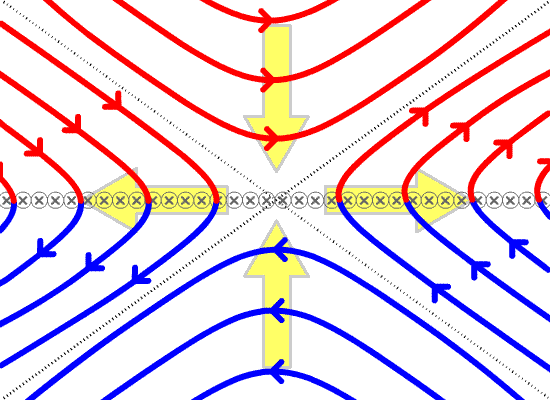
Magnetic reconnection plays a huge role in a wide range of phenomena in the universe, from tokamak plasmas to accretion disks around black holes. On the Sun, this process is likely to be responsible for heating its upper atmosphere to a million degrees. Furthermore, it is also a candidate for the driving mechanism behind flares, Ellerman Bombs, UV bursts, surges and coronal jets. This process is tricky to simulate, as a typical reconnection site comprises a current sheet that is of several orders of magnitude smaller than the region heated by a reconnection event (e.g. a flare). To deal with this, one often (unless the resolution is extremely high) has to set the electrical resistivity around the current sheet to a value higher than the actual resistivity of the Sun in order to diffuse the current sheet to be numerically resolvable. To do this without ruining the physics around the reconnection site, one must choose a resistivity model wisely.
In our study, we run a selection of numerical experiments with magnetic reconnection, applicable for the solar atmosphere, with a few different resistivity models, including the hyper-diffusive resistivity model of Bifrost. The results show some notable differences in how each resistivity model handle magnetic reconnection. For instance, the results obtained when using Bifrost’s hyper-diffusion model has a higher level of plasmoid instability than the results obtained with the other resistivity models that have been used in this study. This is also more in agreement with results obtained with applying a uniformly low resistivity and a higher numerical resolution. Despite of this, the large-scale results in terms of inflow velocity, Poynting influx and Joule heating obtained with the different resistivity models are more or less in good agreement with each other. The major take-away with Bifrost’s hyper-diffusive resistvity model is that it can be applied for the whole solar atmosphere without rescaling its free parameters for different parts of the atmosphere.


To the left: images of the Sun capturing a solar flare at March 28, 2023 on the courtesy of NASA/SDO. To the right: Animation of magnetic reconnection. Credits: ChamouJacoN for Wikipedia.
This Friday colloquium will be hybrid. Attendees can therefore participate either in-person or via Zoom. Please join via Zoom at
https://uio.zoom.us/j/69001043754?pwd=cEJpbVE5ci9PdWNtRld2TDNNcGtKdz09
Meeting ID:690 0104 3754
Passcode: PeiseStua3
Attendees will be muted during the colloquium, but will have the opportunity to ask questions at the end by clicking on the "raise hand” button (or send a request via chat).